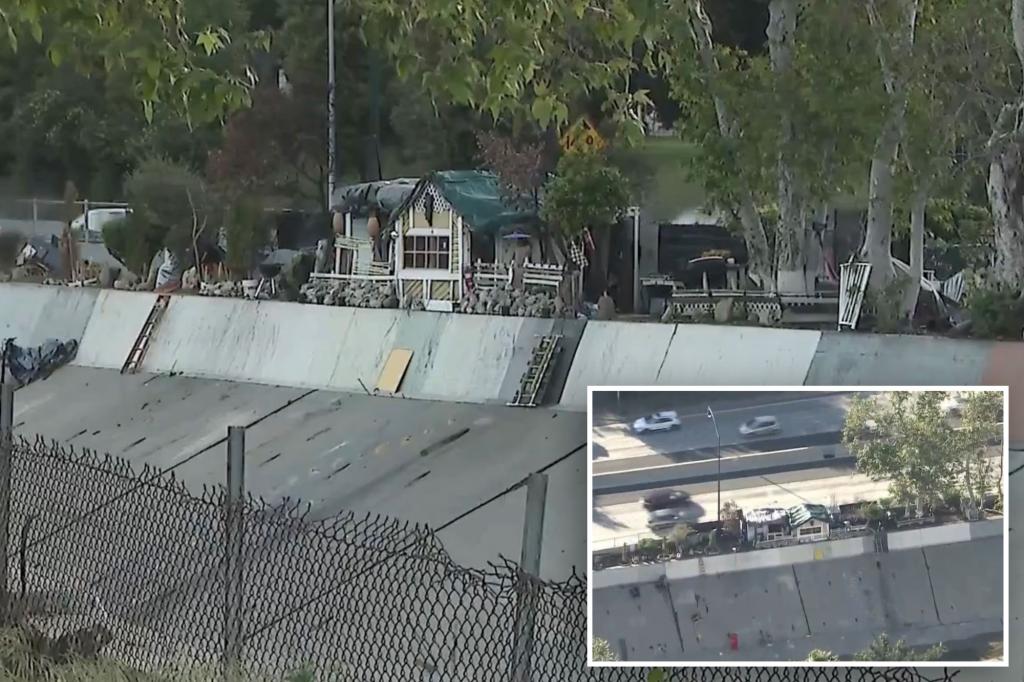A group of homeless Californians in Los Angeles has built a remarkable house-like structure complete with rock walls, a garden, a barbecue grill, a hammock, decorative string lights, potted plants, and working electricity on a strip of land located between a busy freeway and the Arroyo Seco. This stands out among the numerous makeshift shelters and tents constructed by other homeless individuals in the area. The number of encampments in this location has increased in recent years, reflecting the growing homelessness crisis in Los Angeles, with an estimated 46,000 residents without homes.
Despite the impressive nature of the makeshift house, the inhabitants did not speak to the local news station that filmed the structure. Neighbors had mixed reactions to the encampment, with one resident expressing that they did not bother him as most of them kept to themselves. However, other neighbors like Mike Ancheta acknowledged the work put into the structure but believed that such shelters should not be present on public property, citing safety concerns related to open fires and electricity theft. Photos of the encampment show that fire extinguishers are present in the “yard”, suggesting some degree of preparedness for emergencies.
Enrique Rodriguez expressed sympathy for the homeless individuals living in the makeshift house but also noted that he could not overlook any mistakes they may have made. Another resident, Ulysses Chavez, placed blame on the high rental costs in Los Angeles, suggesting that lowering rent and other expenses in the city could help alleviate the homelessness crisis. The wider community’s reactions to the encampment highlight the complex and challenging issues surrounding homelessness and housing insecurity in Los Angeles, with differing perspectives on the presence of makeshift shelters on public land and the need for systemic changes to address the root causes of homelessness.
The unauthorized house-like structure built by homeless individuals near the 110 freeway illustrates the innovative ways in which individuals facing homelessness seek to create stable and comfortable living environments despite their challenging circumstances. The existence of such encampments raises questions about public policy, poverty, housing affordability, and social services in Los Angeles and other cities grappling with high population displacement and rising living costs. The makeshift house also serves as a visible reminder of the need for collaborative solutions that can provide safe and dignified housing for all residents, regardless of their economic status.
While some neighbors express understanding and empathy towards the homeless individuals living in the makeshift house, others voice concerns about safety, property rights, and the legality of occupying public land without permission. The tension between compassion for those experiencing homelessness and desires for public order and safety underscores the urgent need for comprehensive and compassionate approaches to housing insecurity in Los Angeles. As encampments become more visible and prevalent in urban areas, policymakers, community members, and service providers must work together to address the complex challenges faced by those without stable housing and create sustainable solutions that prioritize human dignity and well-being.
In conclusion, the story of the homeless individuals building a house-like encampment in Los Angeles sheds light on the multiple dimensions of homelessness, poverty, and housing insecurity in the city. The makeshift structure serves as a symbol of resilience, creativity, and resourcefulness in the face of adversity, while also highlighting the inadequacies of the current housing system in meeting the needs of all residents. By engaging in conversations about root causes, systemic solutions, and community support, it is possible to work towards a more equitable and inclusive society where everyone has access to safe and affordable housing, regardless of their socioeconomic status.


